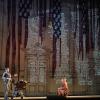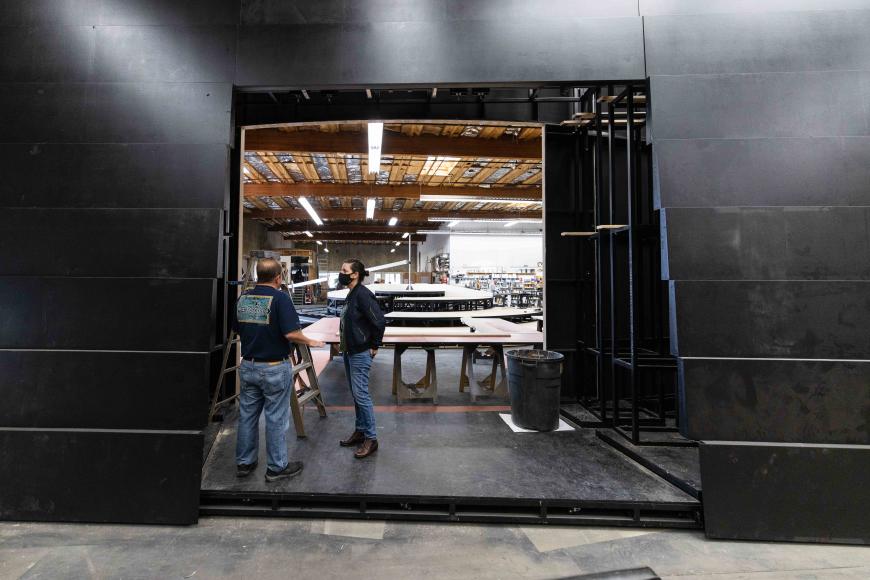
Set designer Mimi Lien is a busy person. Not as busy as in the early 2010s, when her resume lists six or seven productions designed each year — “When I was younger, I felt that there was something to be learned from every project,” she says — but now she goes with her gut feeling, so she’s definitely taking on lots of new challenges. She still takes time to thoughtfully answer questions, has an open laugh, and didn’t seem at all rushed during a half-hour conversation.
Best known for her 2017 Tony Award for Natasha, Pierre & the Great Comet of 1812 (she also won a Lucille Lortel Award for the show’s original off-Broadway production), Lien’s star was already shining in the industry by that time. Her designs show an architectural sense of sculpting a theater space, no surprise since she majored in architecture at Yale University before receiving a graduate degree in set design from New York University. She creates what’s needed for the piece. While Natasha is a wildly exuberant design, her work on Sarah Ruhl’s play The Oldest Boy for Lincoln Center Theater is the opposite, spare and elegant, imparting momentum to the piece.
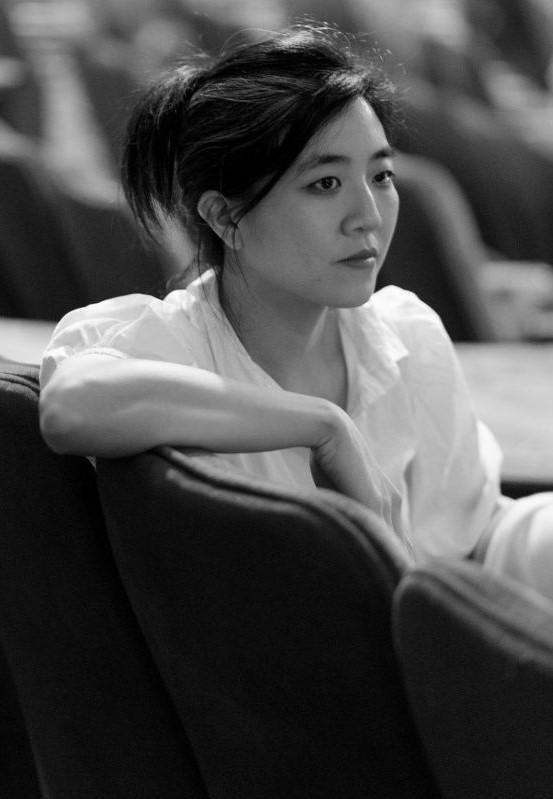
She is still the only set designer to ever win a MacArthur Fellowship (in 2015), which I think makes her a certified genius. But she’s no stranger to awards and accolades, so maybe she took it in stride. “Actually, it was completely out of the blue,” she confesses, modestly. “Shock. I think it’s the only time in my life that I felt like I was really about to faint.”
Lien is the designer for San Francisco Opera’s world premiere production of Antony and Cleopatra by John Adams. The project was an immediate yes because she’s always wanted to work in opera. She played classical music as a child but started off in theater and then dance and to date has only a few operatic projects to her credit. Adams himself was a draw, she explains. “Seeing Doctor Atomic at the [Metropolitan Opera] was kind of a formative experience for me, so I was keen to work on a piece with him.” But so was the production’s director, Elkhanah Pulitzer, who Lien met through a mutual acquaintance, and they hit it off.
The designs for Antony and Cleopatra reflect the conceptual approach that Pulitzer and Adams had been working out as the opera developed — but highly refined by the design team, including costume designer Constance Hoffman. No matter how the critics react to the new opera, the designs are striking and intriguing, promising a unique theatrical experience.
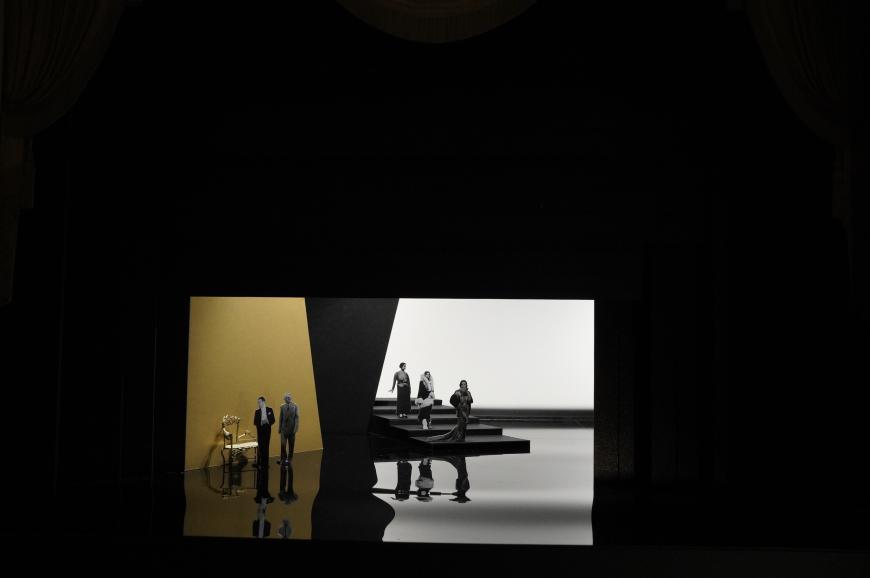
“I was really interested in the idea of Cleopatra,” Lien says, explaining the origins of the design, “a woman who’s ostensibly non-white, although Hellenistic, but an Egyptian woman who’s been represented throughout Hollywood history and all these iterations, seen through a Western lens. This production proposes to really examine that.
“When Elkhanah approached me, there was already this idea of a sort of Busby Berkeley era of Hollywood glamor that we would be using. But really, starting with filmic interpretations of this story meant all of the films, because there have been so many.”
I ask whether that art deco style appeals to her, aesthetically. “It is a style that I really like,” she responds, “but I started looking at it [in depth] because we were talking specifically about 1930s Hollywood. So it’s interesting that dovetailing between art deco architectural detail, [the style] actually borrowed so much from Egyptian architecture. All of these 1930s art deco movie palaces, like the Egyptian Theatre [which originally opened in 1922 in Los Angeles].
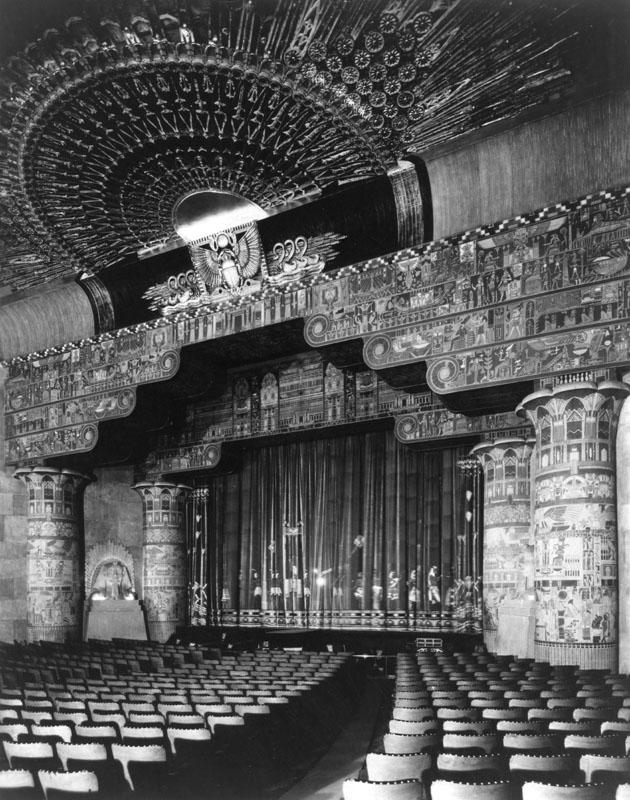
“We did decide we weren’t going to be strictly in the 1930s, so we’re not going to transpose the entire thing. … We also wanted to go back to the actual ancient Egyptian and Roman details and styles. So we decided we would create a style that would be a hybrid between 30 B.C.E. and 1930s Hollywood and a kind of current contemporary media lens.”
“Lens” is perhaps the operative word, since a major element of the design is an opening that Lien calls the aperture. “It’s a [mobile] framing device that is downstage, through which we view the world,” she explains. “What we talked about a lot was the creation of image. The fact that someone like Beyoncé today, for example, has this huge media machine and a very studied, deliberate way that she wants to present herself to the world, and she’s in charge. We talked about Cleopatra having the agency to manipulate and disseminate media images in order to establish her power.
“So we talked about how we were going to put that on stage. We decided against having the whole stage look like a soundstage — that’s a little too concrete and too flimsy. We wanted to be able to be both in the cinematic grandeur and see the edges of it. So this framing device allows us to both zoom out to see the edges, how the image is constructed, and zoom in and crop out the lights and see the image [as seen by a filmgoer].
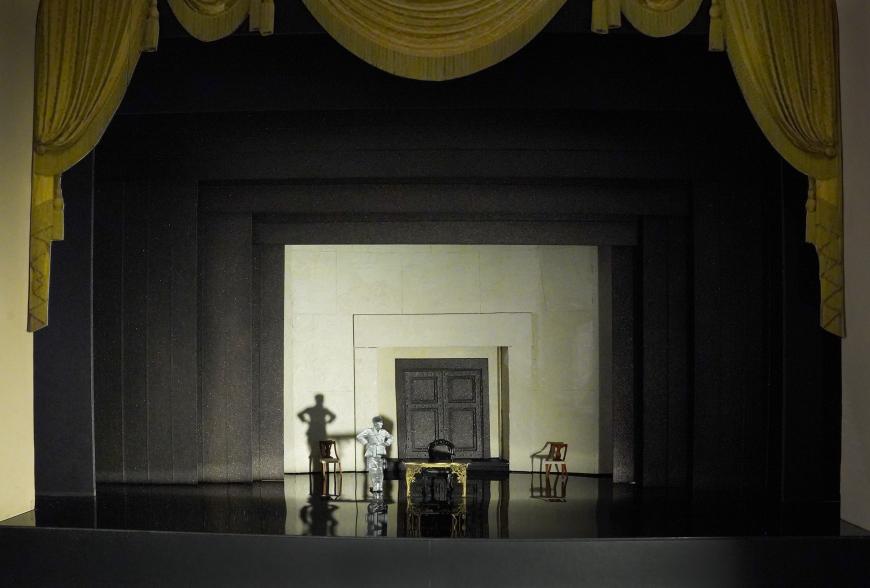
“We’re also talking a lot about public and private because John Adams’s interest in Antony and Cleopatra was really their story as a mature love story. While they both have these public personas, what is their private relationship like? What is a private relationship between these two very public, powerful figures. The aperture, the cropping, allows us to show, OK, this is what is shown to the public, and this is what it is in reality.”
Lien says that the starting point for any design is how it will move, which seems like an odd thing to say about a set. But she means how the design accommodates scene change, which you have to consider, even if you’re building a unit set for a whole show. “Performative architecture, then, has a rhythm and cadence,” she tells me. In this case, the design has to accommodate the regular alternation of scenes between Alexandria and Rome.
“My impulse was that these two worlds were kind of flip sides of a coin in a way,” Lien continues. “And I felt that the movement between them should be a slow rotation. And so, what I ended up designing were these two units that live back to back for the most part and rotate, as if on a turntable.
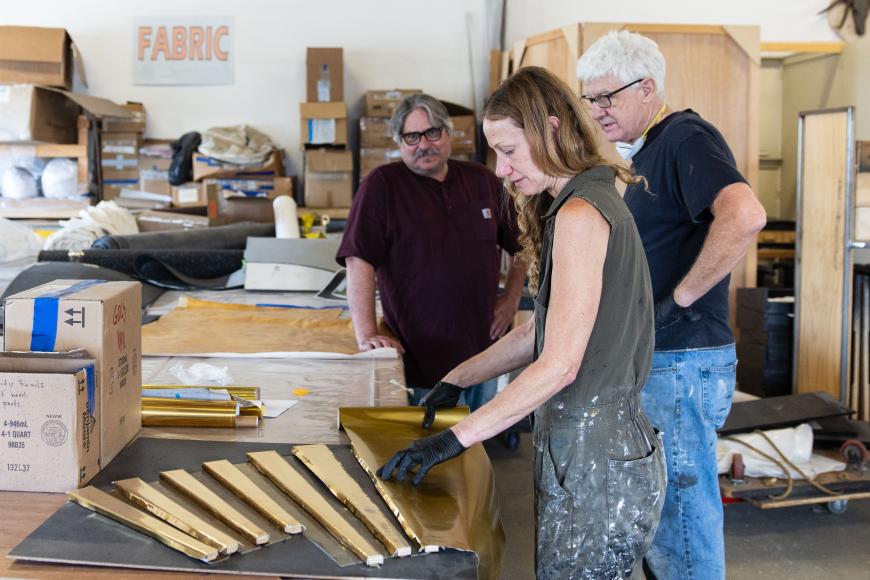
“We talked about the cultural perceptions of Egypt and Rome, which is part of the whole ‘viewing Egypt from a Western lens’ [concept]. And so Cleopatra and Egypt are seen as exotic, represented in a more “feminine” way. Things are more flowy and gold in Hollywood, with lots of fabric. And Rome is “masculine,” and everything is made out of stone, and there’s columns and right angles. So there’s this dichotomy visually and architecturally. It felt right that they were two sides of a coin.
“And then there’s this big battle at the end of Act 1, and at that point the two units, which you’ve been seeing back to back, actually split. And the battle is a naval battle, so the two units part, and the battle takes place in the middle.”
Turning this design into solid reality was a challenge, says scene shop foreman John Del Bono, because the two units will be moved by crew inside, not on a turntable. The shops have been going full blast for a year; San Francisco Opera’s season has three new productions, each of which take four months to build. The departments responsible for the build collaborate with the technical department, whose draftsmen turn out the set blueprints from Lien’s drawings.
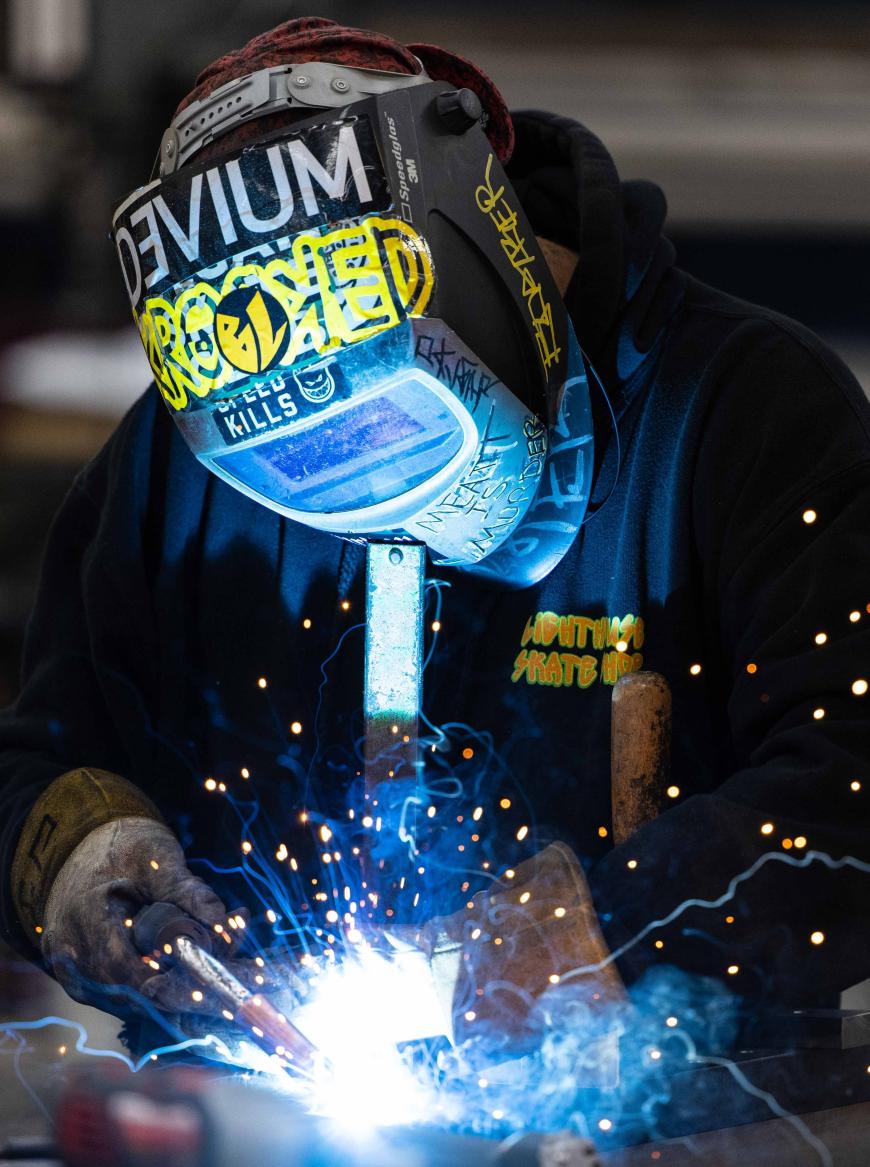
“We looked at Mimi’s drawings,” Del Bono tells me, “and tried to determine how to build the object she’s drawn in a way that works well for shipping [from the scene shop], for onstage moves, for offstage storage, for end-of-show storage. We try to anticipate all the ways it will be handled between the time that we build it and the time that the show strikes at the end of the run. With this design, there was a lot of ‘how do we actually do this in the physical world?’ She’s got interesting angles and cantilevers and all sorts of weird, head-scratching ‘looks neat but can we pull this off’ [challenges]. A lot of this build’s discussion went into thinking about materials and weights. Have you seen the drawing of the Egypt unit?”
Yes, I answer. It’s tall (24 feet), and it has to move — the nightmare combo for technical staff. “First, we had to make sure that it didn’t tip over,” says Del Bono, “so the bottom is built pretty heavy. We put a lot of mass down there, and then we made sure that there was room on the end that wants to tip up, and we put 750 pounds of extra iron that’s distributed along the back side — they just finished the build this morning. That’s to keep it in balance while [stage crew] push it around. Then we had to make sure [that] the higher we went, the lighter the materials. The bottom has all the load on it, and as you get to the top, we used paper, thin woods, and really thin steel to frame it all out.”
And how easy will it be to move? “We have a phenomenal carpentry crew that’s up to this challenge, but we’ll have to see when it goes on stage. There’s going to be cameras and reference points” to keep the unit where it’s supposed to be, he explains. “An additional challenge is that Mimi’s asked for a shiny black floor, and so we’ll lay down a vinyl dance floor, which tends to want to bunch up underneath the wheels. But we have a good plan, and we always figure it out.”




